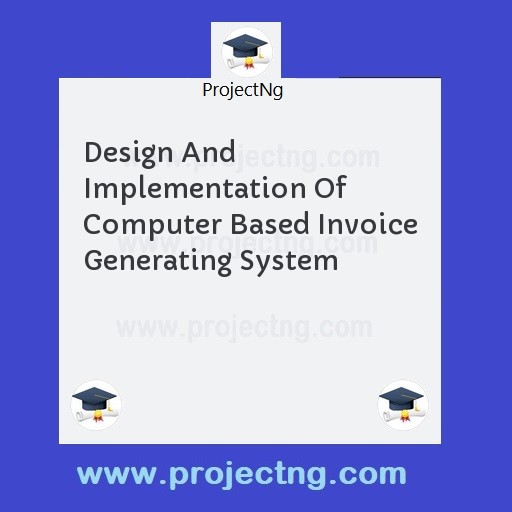Design And Implementation Of Computer Based Invoice Generating System
Computer Science Project Topics
Get the Complete Project Materials Now! »
ABSTRACT
Design and implementation of computer based invoice generating system is one that generates a commercial recording document for both buyer and seller. It also identifies trading parties and list, describes and quantifies the items sold. Different record keeping systems has been practiced by different companies in this country Nigeria. This has resulted in not having a comprehensive data base for invoice recording. This has led to customers wasting a lot of time in an attempt to collect the manual invoice. Also there is poor accountability which has led to the embezzlement of fund. Design and implementation of computer based invoice generating system is aimed at building a web database for storing and recording of goods sold with invoice id number, giving account of invoice generated within a specified period of time and helps to manage and record payment. The methodology used is UNIFIED MODELING LANGUAGE (UML). UML is a standardized modeling language enabling developers to specify, visualize, construct and document artifacts of the system. The researcher used this methodology in the design of the software and it was implemented using notepad++ on a Microsoft windows system using HTML codes, PHP, CSS, and MySQL language for the relational database. The result gotten from this project was a computer based invoice generating system whereby the users of the system have to create account before having access to use the system and admin is the only person that has the privilege to edit, delete an invoice that is discarded by a customer.
TABLE OF CONTENTS
Tittle Page I
Certification II
Approval Page III
Dedication Page IV
Acknowledge Page V
Abstract VI
Table of Contents VII-VIII
List of Figures IX
List of Tables X
CHAPTER 1
- Background of study 1
1.1 Statement of the problem 2
1.2 Objective of the study 2
1.3 Significance of the study 2
CHAPTER 2
- Introduction 4
2.1 Theoretical background 4
2.2 Review of related literature 7
2.3 Summary 11
CHAPTER 3
3.0 Introduction 12
3.1 Analysis of existing system 16
3.2 Use case diagram 18
3.3 Analysis of proposed system 21
3.4 Design of the proposed system 21
3.4.1 Design of proposed system 21
3.4.2 System architecture 25
3.4.3 Input design 25
3.4.4 Output design 27
CHAPTER 4
4.0 Introduction 28
4.1 Choice of development environment 28
4.2 Implementation Architecture 31
4.3 Software Testing 32
4.3.1 Input Specification 33
4.3.2 Output Specification 34
4.4 Documentation 35
4.4.1 User Manual 36
CHAPTER 5
5.0 Summary 38
5.1 Conclusion 38
5.2 Recommendation 39
References 40
Appendix 42
CHAPTER ONE
INTRODUCTION
- BACKGROUND OF STUDY
Record Keeping is the process of collecting, inputting, storing, classifying summarizing and interpreting data. Record keeping has two facets – financial record keeping and managerial record keeping such as date, address, number of goods purchased, unit price of goods, description of the goods, total amount of specified goods and ground total of all the goods (items) listed in the invoice. The basic purpose of financial record is to assist decision makers in evaluating the financial strength, profitability and future prospects of a business.
The purpose of financial record keeping is to produce financial statement about a business entity. Therefore, this study has been narrowed down to the record keeping system that has been practiced by different companies in Nigeria.
Automatic invoice generation system uses a sequential order of list of items that are entered in an invoice platform, to generate an invoice with items and its price per unit from the relational data base.The system automatically summarizes the listed items due for transactions in the ordered goods document and stores them in the invoice table.
But when invoice information is created manually, the system does not adhere to any sequence/summarization rules you have defined. Rather you manually control the sequence/summarization logic in the way you manually create the pay items.
-
- STATEMENT OF THE PROBLEM
- Lack of comprehensive database for recording the invoicing,
- Time wasted when many customers are waiting to collect manual invoice,
- Manually written invoice are subjected to physical damage,
- Embezzlement of fund due to poor accountability.
-
- AIM AND OBJECTIVES OF STUDY
The objectives include to develop a system that can:
- Store and record all the goods sold with an invoice id number.
- Manage and record payments.
- Provide a unique identification number.
- Give account of income generated within a specified period of time,
- SIGNIFICANCE OF STUDY
With growth of information technology, the study offers numerous values in sales invoice recording system.
- Customers get good services, which include assurance of goods purchased: with this system the company knows that the customer can easy track them down if any of the goods sold to him/ her substandard goods or refurbished and with this the company will make it as a law to abide with the selling of original goods.
- It will provide efficient, effective and timely services: there is no much time wasted when someone is using this system to run his/her business.
- Corruption will be reduced: the apprentice hired to assist to attend to customers will not have access to the admin dashboard so that there won’t temper with the price of the goods sold.
- There will be no conflict between the company and the customers since terms and conditions are clearly stated.
- To make report and company audition easy and accountable: annual report writing will be easy since the system have a way of searching all the invoice produced with the customers’ business name and identification number of the invoice which make the invoice more authenticity in the labour market.
Be the First to Share On Social

Enjoying our content?
Don't miss out on new videos! Subscribe to our YouTube channel for more awesome content.
Subscribe Now!













